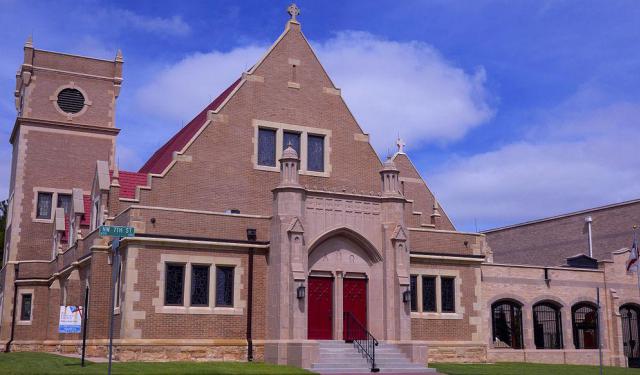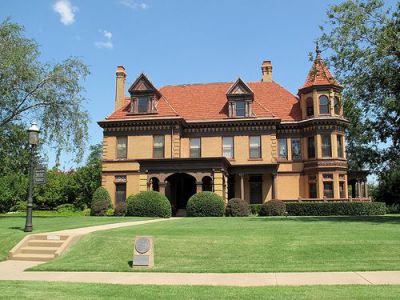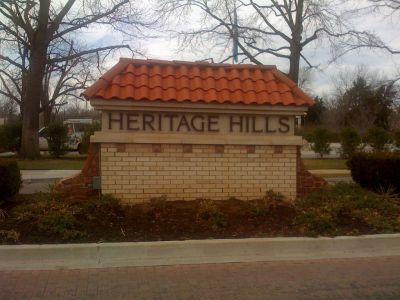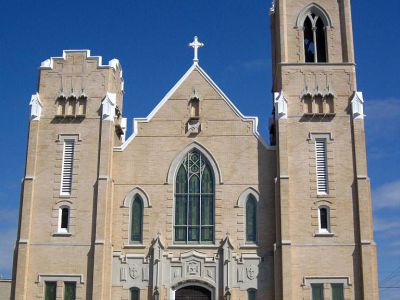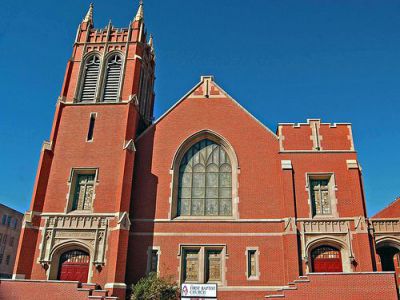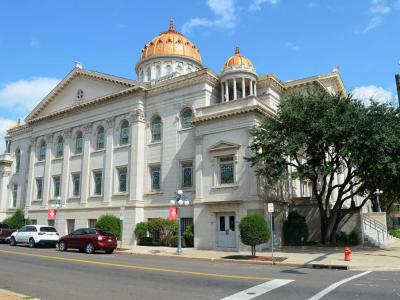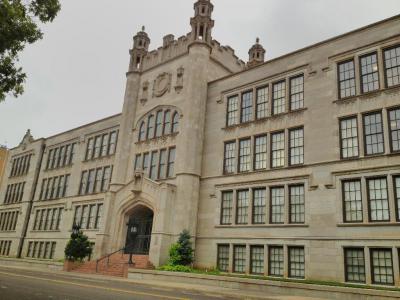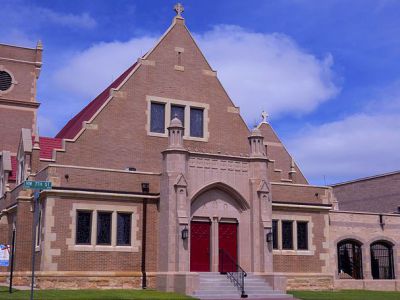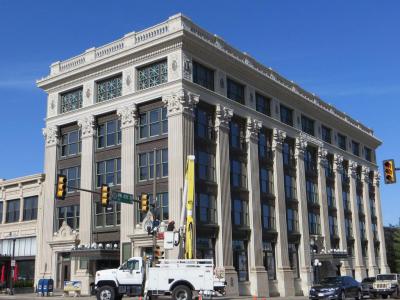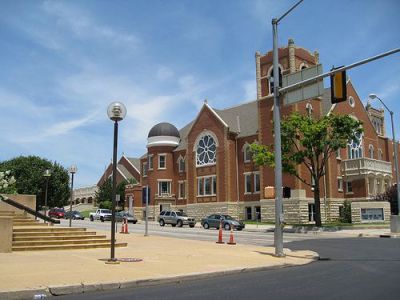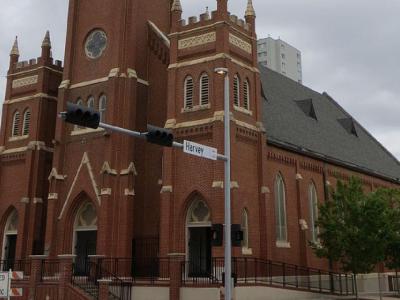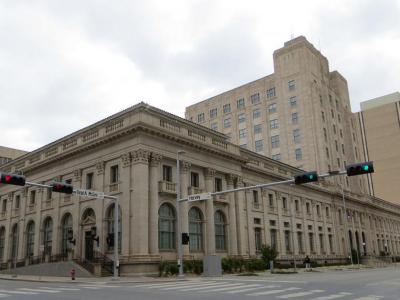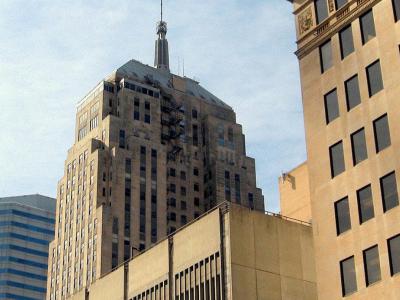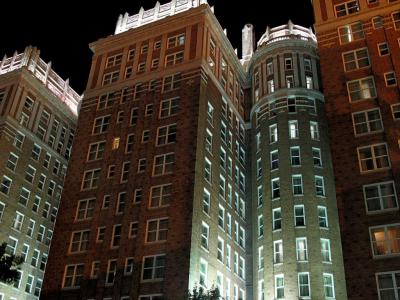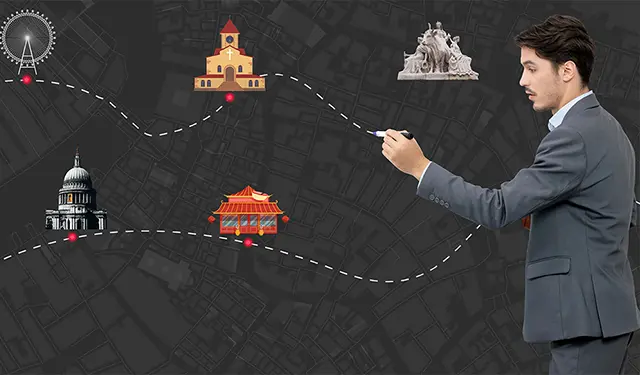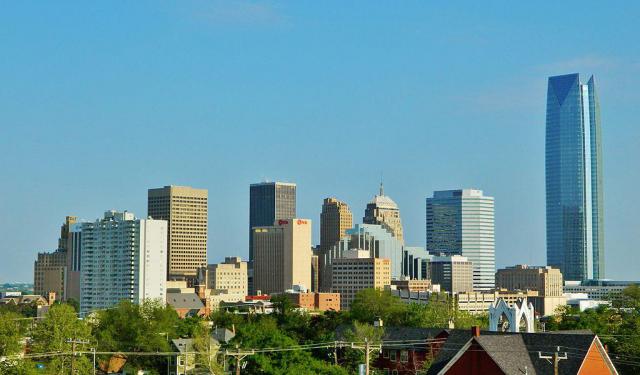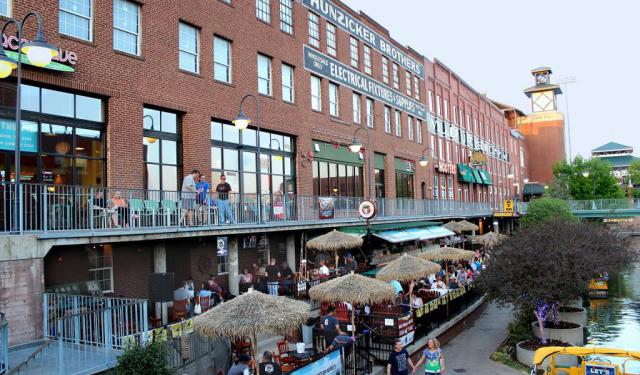Oklahoma City Historical Buildings (Self Guided), Oklahoma City
Home to an attractive variety of historic edifices, the capital of Oklahoma State provides interesting sightseeing opportunities for history buffs and architecture enthusiasts alike. Eye-catching religious sights and structures of great architectural and historic importance abound in downtown Oklahoma City in equal measure.
A brief look at some of the notable sites is best started at the Henry Overholser Mansion, a beautifully preserved example of Victorian-era style, showcasing the opulence of the early 1900s, to be followed by another mansion, named after Robert A Hefner, an exquisite piece of neoclassical design.
The First Lutheran, First Baptist, First United Methodist, and First Christian churches – serving as spiritual cornerstones in the city for over a century – are fine representations of the late 19th and early 20th-century ecclesiastical architecture. Similarly to them, Saint Paul's Episcopal Cathedral and Saint Joseph's Old Cathedral, the striking examples of Gothic masonry, have been a center of worship and community for many generations.
Central High School's building exudes a sense of grandeur and has played a crucial role in the city's educational history. Meanwhile, the E K Gaylord Building symbolizes the city's commercial and entrepreneurial heritage.
The iconic Federal Courthouse and Old Post Office building combines neoclassical and Renaissance Revival styles, serving as a reminder of the city's federal history. At the same time, the Oklahoma County Courthouse, a fine example of Art Deco design, reflects the city's commitment to justice.
In the same vein, the First National Center, a symbol of Oklahoma City's financial legacy, and the historically rich Skirvin Hotel, the city's oldest, represent an accomplishment of Art Deco architecture.
Together, these architectural gems hold stories of the city's growth and transformation. By far not just relics of the past, they manifest the city's enduring spirit set in stone. Whether you're a resident or a visitor, taking the time to explore them in more detail is bound to be a rewarding experience that will enrich your knowledge of Oklahoma City's heritage. A couple of hours of your time truly well spent!
A brief look at some of the notable sites is best started at the Henry Overholser Mansion, a beautifully preserved example of Victorian-era style, showcasing the opulence of the early 1900s, to be followed by another mansion, named after Robert A Hefner, an exquisite piece of neoclassical design.
The First Lutheran, First Baptist, First United Methodist, and First Christian churches – serving as spiritual cornerstones in the city for over a century – are fine representations of the late 19th and early 20th-century ecclesiastical architecture. Similarly to them, Saint Paul's Episcopal Cathedral and Saint Joseph's Old Cathedral, the striking examples of Gothic masonry, have been a center of worship and community for many generations.
Central High School's building exudes a sense of grandeur and has played a crucial role in the city's educational history. Meanwhile, the E K Gaylord Building symbolizes the city's commercial and entrepreneurial heritage.
The iconic Federal Courthouse and Old Post Office building combines neoclassical and Renaissance Revival styles, serving as a reminder of the city's federal history. At the same time, the Oklahoma County Courthouse, a fine example of Art Deco design, reflects the city's commitment to justice.
In the same vein, the First National Center, a symbol of Oklahoma City's financial legacy, and the historically rich Skirvin Hotel, the city's oldest, represent an accomplishment of Art Deco architecture.
Together, these architectural gems hold stories of the city's growth and transformation. By far not just relics of the past, they manifest the city's enduring spirit set in stone. Whether you're a resident or a visitor, taking the time to explore them in more detail is bound to be a rewarding experience that will enrich your knowledge of Oklahoma City's heritage. A couple of hours of your time truly well spent!
How it works: Download the app "GPSmyCity: Walks in 1K+ Cities" from Apple App Store or Google Play Store to your mobile phone or tablet. The app turns your mobile device into a personal tour guide and its built-in GPS navigation functions guide you from one tour stop to next. The app works offline, so no data plan is needed when traveling abroad.
Oklahoma City Historical Buildings Map
Guide Name: Oklahoma City Historical Buildings
Guide Location: USA » Oklahoma City (See other walking tours in Oklahoma City)
Guide Type: Self-guided Walking Tour (Sightseeing)
# of Attractions: 14
Tour Duration: 2 Hour(s)
Travel Distance: 3.4 Km or 2.1 Miles
Author: Sandra
Sight(s) Featured in This Guide:
Guide Location: USA » Oklahoma City (See other walking tours in Oklahoma City)
Guide Type: Self-guided Walking Tour (Sightseeing)
# of Attractions: 14
Tour Duration: 2 Hour(s)
Travel Distance: 3.4 Km or 2.1 Miles
Author: Sandra
Sight(s) Featured in This Guide:
- Henry Overholser Mansion
- Robert A. Hefner Mansion
- First Lutheran Church
- First Baptist Church
- Frontline Church
- Central High School Building
- St. Paul's Episcopal Cathedral
- E. K. Gaylord Building
- First United Methodist Church
- St. Joseph's Old Cathedral
- Federal Courthouse and Old Post Office
- Oklahoma County Courthouse
- First National Center
- Skirvin Hotel
1) Henry Overholser Mansion (must see)
The Henry Overholser Museum is a beautiful historical mansion dating back to 1903. Today, the Oklahoma Historical Society owns the home, and Preservation Oklahoma, Inc. manages the property. Henry Overholser and his wife, Anna, were responsible for the construction of this mansion. This property has been a significant historical site accessible to the public since 1972.
The mansion's exterior has seen full restoration to help preserve its historical character. Several of the home's chimneys, the roof, and the windows have also been restored, helping to preserve the property's unique character. This preservation is important for maintaining the house's condition because of its place in educating the public about Oklahoma City.
This home sits on land acquired during the Great Land Run in 1889. The architectural style is a unique mixture of Chateau and Queen Anne in a stunning Victorian setting. During the time the Overholser family lived in the home, it was a major center for social events. The interior and the grounds stand as a testament to the home's historical importance.
All tours of this home are guided and include the first floor only. Italian light fixtures grace the home's rooms and perfectly complement the period decor. Hand-painted ceilings are also a vital part of the decor. Belgian woodwork and French stained-glass windows are also popular features.
Visitors will also be able to see the original English carpeting and furniture that the family used, as well as a grand piano. The walls feature canvas painting, with ornate features. Touring this mansion is the perfect way to get a look into the past.
Why You Should Visit:
Henry Overholser Mansion has beautifully preserved historical furniture and artifacts, and is an excellent example of a distinctive architecture for its time.
Tips:
Take the time to look at the original paintings on display in the living areas.
The mansion's exterior has seen full restoration to help preserve its historical character. Several of the home's chimneys, the roof, and the windows have also been restored, helping to preserve the property's unique character. This preservation is important for maintaining the house's condition because of its place in educating the public about Oklahoma City.
This home sits on land acquired during the Great Land Run in 1889. The architectural style is a unique mixture of Chateau and Queen Anne in a stunning Victorian setting. During the time the Overholser family lived in the home, it was a major center for social events. The interior and the grounds stand as a testament to the home's historical importance.
All tours of this home are guided and include the first floor only. Italian light fixtures grace the home's rooms and perfectly complement the period decor. Hand-painted ceilings are also a vital part of the decor. Belgian woodwork and French stained-glass windows are also popular features.
Visitors will also be able to see the original English carpeting and furniture that the family used, as well as a grand piano. The walls feature canvas painting, with ornate features. Touring this mansion is the perfect way to get a look into the past.
Why You Should Visit:
Henry Overholser Mansion has beautifully preserved historical furniture and artifacts, and is an excellent example of a distinctive architecture for its time.
Tips:
Take the time to look at the original paintings on display in the living areas.
2) Robert A. Hefner Mansion
The Robert A. Hefner Museum dates back to 1917 and was Mr. Hefner's home from 1927 to 1947. This home's style is Greek Revival, designed by Albert F. Stewart. Over time, the building has served as a home to the Oklahoma Historical Association Hall of Fame.
Today, the home is owned by St. Luke's United Methodist Church, where it plays a significant role in the congregation's mission. One of the focal areas inside the house is the chapel, which the family donated. Baptisms, prayer, and meditation take place here regularly.
Visitors will enjoy being able to tour the grounds, which stand out as one of the city's top contemplative spaces. The courtyard is paved with bricks, many of which commemorate the loved ones of church members.
The statue known as the "Christmas Box Angel" that author Richard Paul Evans donated has its home on the museum grounds. Prayer and reflection are favorite activities for people who visit these grounds.
Today, the home is owned by St. Luke's United Methodist Church, where it plays a significant role in the congregation's mission. One of the focal areas inside the house is the chapel, which the family donated. Baptisms, prayer, and meditation take place here regularly.
Visitors will enjoy being able to tour the grounds, which stand out as one of the city's top contemplative spaces. The courtyard is paved with bricks, many of which commemorate the loved ones of church members.
The statue known as the "Christmas Box Angel" that author Richard Paul Evans donated has its home on the museum grounds. Prayer and reflection are favorite activities for people who visit these grounds.
3) First Lutheran Church
The First Lutheran Church stands as an elegant testament to early 20th-century Gothic Revival architecture. Constructed in 1912 by noted local architects VanSlyke & Woodruff, the structure features twin Gothic towers, a red-tiled gable roof, and creamy-hued façades punctuated by a mix of lancet, tall, narrow, and rectangular windows.
Step inside and you’ll be greeted by an equally atmospheric interior: pale-toned walls and ceilings contrast beautifully with dark, ornate altar pieces, paintings, and stained-glass windows that cast a serene glow.
Beyond its architectural beauty, First Lutheran Church holds a fascinating piece of local history: the “Oklahoma Century Chest.” Sealed in 1913 as a time capsule to fund a new pipe organ and unearthed a century later in 2013, this vault contained newspapers, letters, Kodak cameras, pottery, and other artifacts-offering a vivid glimpse into early Oklahoman life.
Step inside and you’ll be greeted by an equally atmospheric interior: pale-toned walls and ceilings contrast beautifully with dark, ornate altar pieces, paintings, and stained-glass windows that cast a serene glow.
Beyond its architectural beauty, First Lutheran Church holds a fascinating piece of local history: the “Oklahoma Century Chest.” Sealed in 1913 as a time capsule to fund a new pipe organ and unearthed a century later in 2013, this vault contained newspapers, letters, Kodak cameras, pottery, and other artifacts-offering a vivid glimpse into early Oklahoman life.
4) First Baptist Church
First Baptist Church was founded in 1889, just months after the iconic Land Run. The congregation originally met in modest rooms before erecting its impressive neo-Gothic sanctuary in 1912. The building’s red-brick façade, twin towers, steep gabled roof, and richly detailed stained-glass windows from 1910 offer a visual contrast amid modern high-rises.
Visitors to First Baptist are invited to explore more than just its exterior. Inside, the sanctuary features a majestic timber-framed ceiling and a grand Casavant pipe organ, installed during the church’s centennial in 1989, underscoring its deep musical heritage.
Beyond worship services, the church remains deeply integrated into the revitalized downtown, engaged in bilingual ministries, refugee outreach, and global missions.
Visitors to First Baptist are invited to explore more than just its exterior. Inside, the sanctuary features a majestic timber-framed ceiling and a grand Casavant pipe organ, installed during the church’s centennial in 1989, underscoring its deep musical heritage.
Beyond worship services, the church remains deeply integrated into the revitalized downtown, engaged in bilingual ministries, refugee outreach, and global missions.
5) Frontline Church
Frontline Church, known historically as the First Christian Church, is one of the city's landmarks, housed in a majestic Neo-Classical Revival building. Built in 1911 and listed on the National Register of Historic Places, the church features a stately gold-leaf dome, Corinthian limestone columns, and stained-glass windows. Inside, the sanctuary’s intricate carvings and historic architecture offer an inspiring backdrop for worship and community gatherings.
Originally planted by Pastor Josh Kouri, Frontline Church now encompasses multiple congregations in Oklahoma City, Edmond, Shawnee, and Yukon. It offers a blend of regular Sunday gatherings, family worship, youth programs, and community initiatives
Originally planted by Pastor Josh Kouri, Frontline Church now encompasses multiple congregations in Oklahoma City, Edmond, Shawnee, and Yukon. It offers a blend of regular Sunday gatherings, family worship, youth programs, and community initiatives
6) Central High School Building
Central High School Building, now home to the Oklahoma City University School of Law, is one of the city’s most architecturally prominent landmarks. Designed by renowned architect Solomon Andrew Layton in the Collegiate Gothic style and completed in 1910, the limestone-clad, castle-like structure features towers with crenellated parapets, heavy stone arches, and symmetrical façades. Initially opened as Oklahoma High School, it was renamed Central High School in 1919 after the district expanded.
This historic building was built with a two-tiered gym, auditorium, swimming pool, and specialized classrooms. It stood witness to over five decades of student life before transitioning into a junior high and later an alternative school until its closure as an educational institution in 1968.
In the early 1980s, Southwestern Bell rescued the structure from deterioration, investing heavily in its restoration and repurposing it as office space under the name “One Bell Central.” The building also played a vital role during the aftermath of the 1995 Oklahoma City bombing-serving as a command center for emergency responders. Since 2015, its storied halls have been dedicated to law students, and a museum within the building preserves artifacts, including restored murals from 1928.
This historic building was built with a two-tiered gym, auditorium, swimming pool, and specialized classrooms. It stood witness to over five decades of student life before transitioning into a junior high and later an alternative school until its closure as an educational institution in 1968.
In the early 1980s, Southwestern Bell rescued the structure from deterioration, investing heavily in its restoration and repurposing it as office space under the name “One Bell Central.” The building also played a vital role during the aftermath of the 1995 Oklahoma City bombing-serving as a command center for emergency responders. Since 2015, its storied halls have been dedicated to law students, and a museum within the building preserves artifacts, including restored murals from 1928.
7) St. Paul's Episcopal Cathedral
Saint Paul’s Episcopal Cathedral is a significant religious and historical site designed in the Norman-Gothic style. The church traces its beginnings to 1891 as a mission, with its first service held in a wooden structure by 1893. Construction of the current building began with the laying of its cornerstone in 1903. It was officially designated as the cathedral in 1909 when the Diocese of Oklahoma established its seat at this location.
Visitors are struck by the cathedral’s features: a robust square Norman tower, soaring wooden-beamed nave, and stained glass-most notably the Tiffany windows framing the altar. Intricately carved Carrara marble elements-including the altar, pulpit, and baptismal font-were imported from Italy in the 1920s. The site has since expanded with a parish house and a educational wing, the latter displaying a warm brick and stone façade that complements the original stonework.
Saint Paul’s today is also a testament to resilience, suffering severe damage in the tragic 1995 bombing-walls were splayed, the roof uplifted, and its iconic Celtic cross shattered. In the aftermath, the cathedral became a place of refuge and healing, offering support, meals, and solace to rescue workers and victims.
Today, Saint Paul’s Episcopal Cathedral offers regular worship services, inspiring musical programs, and an array of outreach ministries-including the Oakerhater Guild and a dedicated chapel honoring the first Native American Episcopal deacon, David Pendleton Oakerhater.
Visitors are struck by the cathedral’s features: a robust square Norman tower, soaring wooden-beamed nave, and stained glass-most notably the Tiffany windows framing the altar. Intricately carved Carrara marble elements-including the altar, pulpit, and baptismal font-were imported from Italy in the 1920s. The site has since expanded with a parish house and a educational wing, the latter displaying a warm brick and stone façade that complements the original stonework.
Saint Paul’s today is also a testament to resilience, suffering severe damage in the tragic 1995 bombing-walls were splayed, the roof uplifted, and its iconic Celtic cross shattered. In the aftermath, the cathedral became a place of refuge and healing, offering support, meals, and solace to rescue workers and victims.
Today, Saint Paul’s Episcopal Cathedral offers regular worship services, inspiring musical programs, and an array of outreach ministries-including the Oakerhater Guild and a dedicated chapel honoring the first Native American Episcopal deacon, David Pendleton Oakerhater.
8) E. K. Gaylord Building
The E. K. Gaylord Building-also known historically as the Oklahoma Publishing Company Building or the Daily Oklahoman Building-is a five-story neoclassical gem, designed by architect Andrew Solomon Layton and completed in 1909. The structure features tall composite-capital columns, ornate cornices, and an elegant balustrade crowning the façade, showcasing early 20th-century architectural flourishes. Having served as the home of The Daily Oklahoman, the building embodies both the civic pride and journalistic ambition of Edward K. Gaylord-who led the newspaper and its parent company.
Today, this historic landmark is listed on the National Register of Historic Places. After an extensive renovation in 1997, it found new life hosting the offices of the Oklahoma Young Men's Christian Association and various community-focused groups.
Today, this historic landmark is listed on the National Register of Historic Places. After an extensive renovation in 1997, it found new life hosting the offices of the Oklahoma Young Men's Christian Association and various community-focused groups.
9) First United Methodist Church
The First United Methodist Church has stood since the city’s founding in the Land Run of 1889. The congregation first gathered under a wood-frame structure built just weeks after the land opened for settlement, formally chartering their church in June of that year. The grand brick sanctuary visible today was dedicated in 1904, and its façade features towering rose windows, dignified porticoes, and distinctive towers that reflect the church’s historic prominence.
It is officially designated United Methodist Historic Site No. 531, a recognition that underlines its significance within both local and denominational history. The church’s significance in Oklahoma City’s history grew after the 1995 bombing of the Alfred P. Murrah Federal Building, which caused severe damage to its sanctuary and education wing. In the aftermath, widespread support fueled a three-year restoration effort., returning to their rebuilt worship space on Easter Sunday in 1998.
Directly across from the Oklahoma City National Memorial, the church also hosts an open-air “Heartland Chapel” built from stones damaged in the blast.
It is officially designated United Methodist Historic Site No. 531, a recognition that underlines its significance within both local and denominational history. The church’s significance in Oklahoma City’s history grew after the 1995 bombing of the Alfred P. Murrah Federal Building, which caused severe damage to its sanctuary and education wing. In the aftermath, widespread support fueled a three-year restoration effort., returning to their rebuilt worship space on Easter Sunday in 1998.
Directly across from the Oklahoma City National Memorial, the church also hosts an open-air “Heartland Chapel” built from stones damaged in the blast.
10) St. Joseph's Old Cathedral
Saint Joseph’s Old Cathedral traces its roots back to the city’s Land Run of 1889. The original modest wooden structure-where early Masses were held in a tent-was built just a month after priest Nicolas F. Scallon arrived, with a 650-lb bell imported. By 1901, a grander Gothic Revival church arose using Coffeyville brick, complete with a soaring central tower flanked by crenellated side towers. Dedicated in late 1904, it became Oklahoma’s first cathedral in 1905, before being renamed the “Old Cathedral” in 1931 when the diocesan seat moved.
Walking through Saint Joseph’s today, visitors encounter luminous stained-glass windows and vaulted ceilings. The church survived years of neglect until a major restoration in 1976 brought back much of its original charm-meticulously cleaned stained glass, restored plaster medallions, polished brass fittings, and refinished pews.
Perhaps the most poignant chapter in the cathedral’s history came after the Oklahoma City bombing in 1995. Though heavily damaged-the blast shattered windows, crushed the pipe organ, and shifted the roof-the resilient congregation led a two-year renovation culminating in a rededication in December 1996. The adjacent Italian marble statue, And Jesus Wept, installed in 1997, serves as a powerful memorial to those lost in the tragedy and a symbol of collective healing.
Listed on the National Register of Historic Places in 1978, it continues to welcome parishioners and tourists alike with weekly Masses and guided quiet reflection.
Walking through Saint Joseph’s today, visitors encounter luminous stained-glass windows and vaulted ceilings. The church survived years of neglect until a major restoration in 1976 brought back much of its original charm-meticulously cleaned stained glass, restored plaster medallions, polished brass fittings, and refinished pews.
Perhaps the most poignant chapter in the cathedral’s history came after the Oklahoma City bombing in 1995. Though heavily damaged-the blast shattered windows, crushed the pipe organ, and shifted the roof-the resilient congregation led a two-year renovation culminating in a rededication in December 1996. The adjacent Italian marble statue, And Jesus Wept, installed in 1997, serves as a powerful memorial to those lost in the tragedy and a symbol of collective healing.
Listed on the National Register of Historic Places in 1978, it continues to welcome parishioners and tourists alike with weekly Masses and guided quiet reflection.
11) Federal Courthouse and Old Post Office
Completed in 1912 shortly after statehood, the Federal Courthouse and Old Post Office, a Beaux-Arts masterpiece, was the city’s first grand federal structure, designed under the direction of Supervising Architect James Knox Taylor.
The building grew in stages, with two westward expansions in 1919 and 1932 that respected the original style but introduced an Art-Deco central tower added by James A. Wetmore. The building features hallmark elements of early 20th-century federal architecture, including ornamental pediments, rounded arches, balustraded facades, and a red-tile roof.
It hosted the Tenth Circuit Court of Appeals and was where infamous gangster “Machine Gun” Kelly was tried in 1933; the trial was notable for permitting sound and camera equipment for the first time in federal court. In 1949, it played a pivotal role in ending segregation in graduate schools during the McLaurin v. Oklahoma State Regents case.
Now serving the U.S. Bankruptcy Court, the courthouse remains a living monument, meticulously restored in the early 1990s by the General Services Administration.
The building grew in stages, with two westward expansions in 1919 and 1932 that respected the original style but introduced an Art-Deco central tower added by James A. Wetmore. The building features hallmark elements of early 20th-century federal architecture, including ornamental pediments, rounded arches, balustraded facades, and a red-tile roof.
It hosted the Tenth Circuit Court of Appeals and was where infamous gangster “Machine Gun” Kelly was tried in 1933; the trial was notable for permitting sound and camera equipment for the first time in federal court. In 1949, it played a pivotal role in ending segregation in graduate schools during the McLaurin v. Oklahoma State Regents case.
Now serving the U.S. Bankruptcy Court, the courthouse remains a living monument, meticulously restored in the early 1990s by the General Services Administration.
12) Oklahoma County Courthouse
Oklahoma County Courthouse is a good example of Art Deco grandeur. Designed by Layton & Forsyth firm, this limestone landmark was constructed in 1936– 1937 using a combination of local bonds and federal Public Works Administration funds during the Great Depression. Its stepped-back silhouette, inspired by Mayan temple forms, is a defining feature of its design ethos.
As you approach, notice the bas-relief mural above the main entrance, depicting what’s described as a “scene of Oklahoma friendship” between figures representing Native American heritage and frontier life. The façade’s sandy-brown Indiana limestone is further embellished with geometric aluminum paneling and inscribed quotes. Inside, the two-story lobby showcases terrazzo floors with compass motifs, wagon-wheel chandeliers, and overlooks at the third-floor level-features that underline its Art Deco and Moderne pedigree.
Placed on the National Register of Historic Places in 1992, the courthouse remains remarkably intact, retaining much of its original character despite the addition of a 1967 modern office building connected by skyways. Beyond its aesthetic appeal, it represents an important chapter in Oklahoma’s county governance, replacing the earlier 1906 Romanesque courthouse.
As you approach, notice the bas-relief mural above the main entrance, depicting what’s described as a “scene of Oklahoma friendship” between figures representing Native American heritage and frontier life. The façade’s sandy-brown Indiana limestone is further embellished with geometric aluminum paneling and inscribed quotes. Inside, the two-story lobby showcases terrazzo floors with compass motifs, wagon-wheel chandeliers, and overlooks at the third-floor level-features that underline its Art Deco and Moderne pedigree.
Placed on the National Register of Historic Places in 1992, the courthouse remains remarkably intact, retaining much of its original character despite the addition of a 1967 modern office building connected by skyways. Beyond its aesthetic appeal, it represents an important chapter in Oklahoma’s county governance, replacing the earlier 1906 Romanesque courthouse.
13) First National Center
First National Center is Oklahoma City’s iconic Art Deco masterpiece, rising 406 feet tall with a distinctive aluminum-topped spire and aviation beacon once visible for miles. Completed in 1931 as the First National Bank and Trust Company headquarters, this 33-story landmark was considered the fourth-largest structure west of the Mississippi, and featured more aluminum than any building globally at the time. It remains a part of Oklahoma City’s skyline and proudly listed on the National Register of Historic Places.
After an extensive $275 million renovation, the building reopened in 2022 as a mixed-use destination. The former banking hall-now the majestic “Great Hall”-features soaring marble columns, intricately restored murals by Edgar Spier Cameron depicting key moments in Oklahoma history, and vintage teller booths.
Guests can stay at The National, an Autograph Collection hotel offering 146 thoughtfully designed rooms inspired by the building’s heritage, or rent one of the luxury “First Residences” apartments upstairs.
Beyond lodging, The Center offers a dynamic public experience: dine at Tellers, an Italian-inspired restaurant in the restored bank gallery; sip craft cocktails in the atmospheric Vault and Mint lounges; enjoy a classic steakhouse meal at Stock & Bond; or unwind in The Great Hall with espresso or aperitivo.
After an extensive $275 million renovation, the building reopened in 2022 as a mixed-use destination. The former banking hall-now the majestic “Great Hall”-features soaring marble columns, intricately restored murals by Edgar Spier Cameron depicting key moments in Oklahoma history, and vintage teller booths.
Guests can stay at The National, an Autograph Collection hotel offering 146 thoughtfully designed rooms inspired by the building’s heritage, or rent one of the luxury “First Residences” apartments upstairs.
Beyond lodging, The Center offers a dynamic public experience: dine at Tellers, an Italian-inspired restaurant in the restored bank gallery; sip craft cocktails in the atmospheric Vault and Mint lounges; enjoy a classic steakhouse meal at Stock & Bond; or unwind in The Great Hall with espresso or aperitivo.
14) Skirvin Hotel
The Skirvin Hotel, Oklahoma City's longest-operating hotel, first welcomed guests in 1911. Commissioned by oilman William Balser “Bill” Skirvin and designed by architect Solomon A. Layton, it quickly became a hub for the city’s social and political scene. Listed on the National Register of Historic Places in 1979, the hotel closed in 1988 but later underwent a major $50 million renovation. It reopened in 2007 as The Skirvin Hilton, blending its original 1911 charm and Art Deco grandeur with modern amenities.
Guests can enjoy dining at the Park Avenue Grill, offering contemporary takes on local cuisine, or unwind in the Red Piano Lounge, known for its classic cocktails and live jazz in a stylish setting. The hotel also features an indoor pool, fitness center, and bar, along with 24-hour room service.
Strategically situated just steps from the Bricktown entertainment district, the Oklahoma City National Memorial, Cox Convention Center, and Oklahoma City Museum of Art, the Skirvin makes an ideal base for exploring the city's top cultural and recreational spots.
Guests can enjoy dining at the Park Avenue Grill, offering contemporary takes on local cuisine, or unwind in the Red Piano Lounge, known for its classic cocktails and live jazz in a stylish setting. The hotel also features an indoor pool, fitness center, and bar, along with 24-hour room service.
Strategically situated just steps from the Bricktown entertainment district, the Oklahoma City National Memorial, Cox Convention Center, and Oklahoma City Museum of Art, the Skirvin makes an ideal base for exploring the city's top cultural and recreational spots.
Walking Tours in Oklahoma City, Oklahoma
Create Your Own Walk in Oklahoma City
Creating your own self-guided walk in Oklahoma City is easy and fun. Choose the city attractions that you want to see and a walk route map will be created just for you. You can even set your hotel as the start point of the walk.
Oklahoma City Introduction Walking Tour
As the state capital of Oklahoma, Oklahoma City is the largest city in this state. Much of the city's settlement occurred during the Great Land Rush of 1889. Native Americans representing several tribes were among some of the region's earliest settlers. Tribal emblems and imagery make up much of the symbolism common in this city.
Many of the city's most iconic buildings date back... view more
Tour Duration: 2 Hour(s)
Travel Distance: 4.5 Km or 2.8 Miles
Many of the city's most iconic buildings date back... view more
Tour Duration: 2 Hour(s)
Travel Distance: 4.5 Km or 2.8 Miles
Downtown To Bricktown
Oklahoma City's Downtown and vibrant Bricktown area to its east complement each other, housing some of the most prominent landmarks in the city, including abundant dining and entertainment options that the state capital has to offer.
On this self-guided walk, you will start from the Oklahoma City National Memorial downtown, a poignant reminder of the tragic events of April 19, 1995. The... view more
Tour Duration: 1 Hour(s)
Travel Distance: 2.4 Km or 1.5 Miles
On this self-guided walk, you will start from the Oklahoma City National Memorial downtown, a poignant reminder of the tragic events of April 19, 1995. The... view more
Tour Duration: 1 Hour(s)
Travel Distance: 2.4 Km or 1.5 Miles
The Most Popular Cities
/ view all
